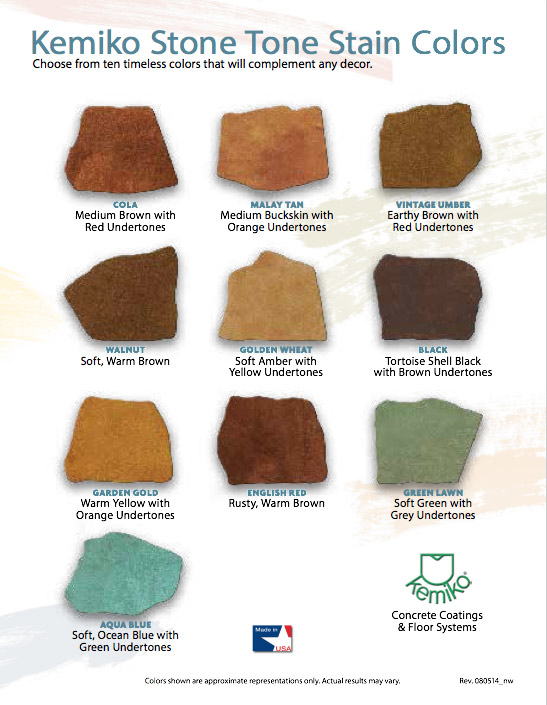Concrete Stain – Acid Stained Concrete in Chattanooga, Huntsville, & Nashville
Acid Stained Concrete
Acid stained concrete creates beautiful, varied colors on exterior or interior concrete stain by reacting with the cement on the concrete's surface. Acid stains are very durable and the colors they yield will last as long as the concrete surface that they are applied on. Every concrete floor contains a different amount of minerals resulting in variation in coloration and shading. The mottled and varied appearance of these floors is common and is also one of the big reasons concrete stain has so much appeal.
Links
Surfkoat Heritage Acid Stain TDS
Kemiko Stone Tone Concrete Stain
Kemiko Stain Color Chart
Videos:
Kemiko Video
Water-based Concrete Stain
 < Click image to enlarge
< Click image to enlarge
Water-based concrete stain is a transparent stain that eliminates the need for neutralizing the chemical reaction required by acid staining. Water-based stains do not contain caustic ingredients and can be used as an alternative to solvent and acid-based staining. If you are looking to rejuvenate existing interior or exterior concrete with less work water-based staining might be your desired product.
Links:
SikaColor-430 Elements Product Data Sheet Link
Surecrete Eco Stain
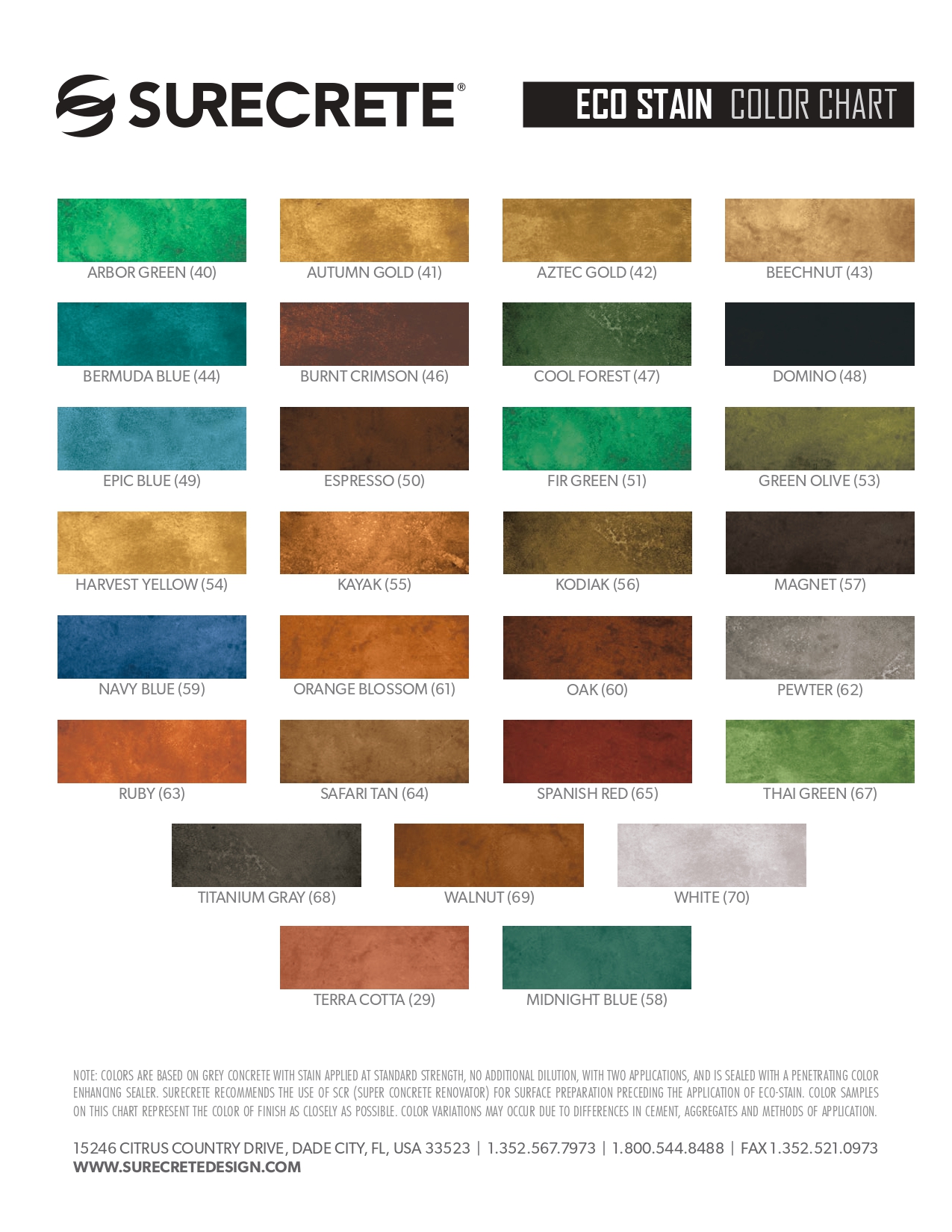 < Click image to enlarge
< Click image to enlarge
Eco-Stain™ is a liquid semi-transparent water-based concrete stain for accent coloring that can be sprayed, brushed rolled or even sponged. Used for staining concrete floors and walls including overlays and cast concrete products. New for 2017, Eco Stan is now available in a concentrated liquid 32oz. bottle that makes one full gallon and a 128 oz. concentrated bottle. Offered in 30 UV stable concrete stain colors, Eco-Stain™ can be diluted up to 10:1 to create virtually any color stain color desired. Applying concrete dyes has never been easier.
Links
Surecrete Eco Stain Technical Data Sheet
Acetone Concrete Stain
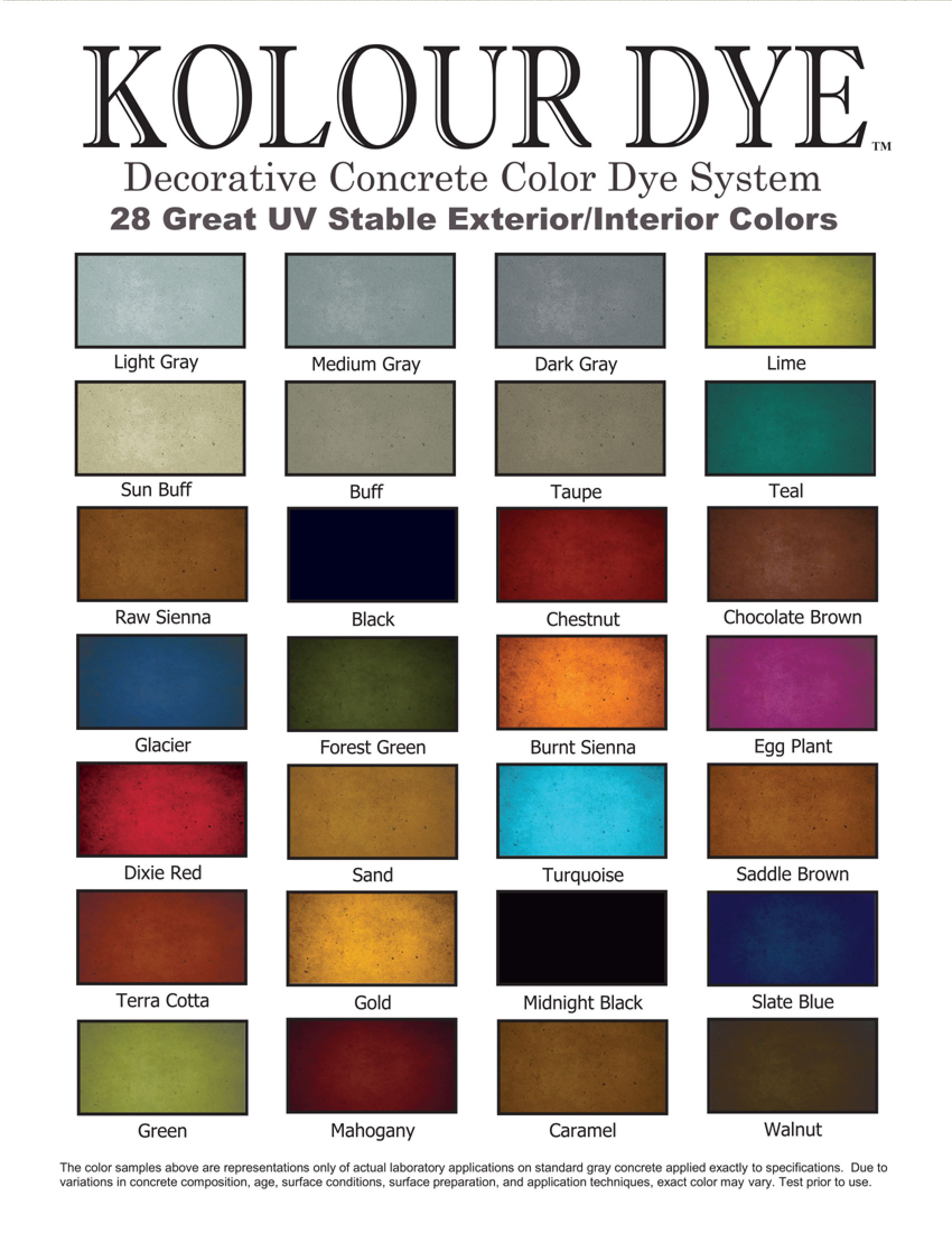 < Click image to enlarge
< Click image to enlarge
Acetone concrete stain is a versatile transparent stain that can go on interior or exterior cured concrete surfaces. This stain uses acetone as the penetrating agent for the stain and dries very quickly. This exterior or interior concrete stain available in our Chattanooga, Nashville & Huntsville locations creates a solid coloration with slight modeling effects but can be enhanced depending on the technique and color combinations used. This product is UV stable, so using it outside or in a room that receives natural light will not result in the color fading over time. While other stains can be applied using a standard pump sprayer, any stain using acetone will require an acetone sprayer. Otherwise, the acetone will eat through the seals in the standard sprayer and create a mess. This product CANNOT be polished.
Links:
Surfkoat Exterior Kolour Dye TDS
Acetone Dye
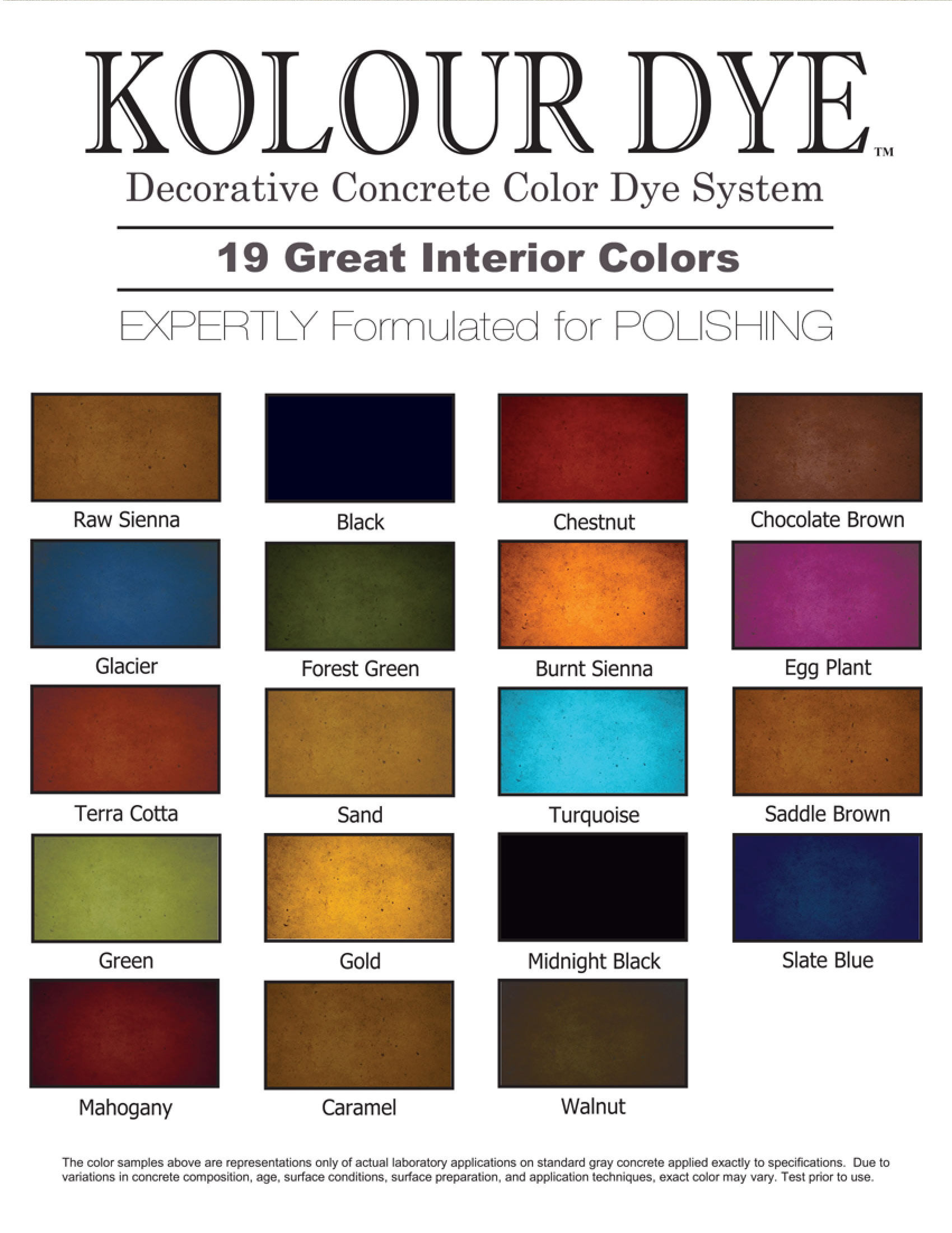 < Click image to enlarge
< Click image to enlarge
Acetone dye is a product that is only used on properly prepped interior surfaces with limited natural light. Unlike acetone stain, acetone dye penetrates further into the surface of the concrete and can be used when utilizing a concrete polishing machine to finish the surface. Acetone dye is a transparent stain that gives a solid coloration, but can be manipulated to create a modeling effect by using specific techniques or adding another color.
Links
Polishing Kolour Dye
Sealer Concrete Stain
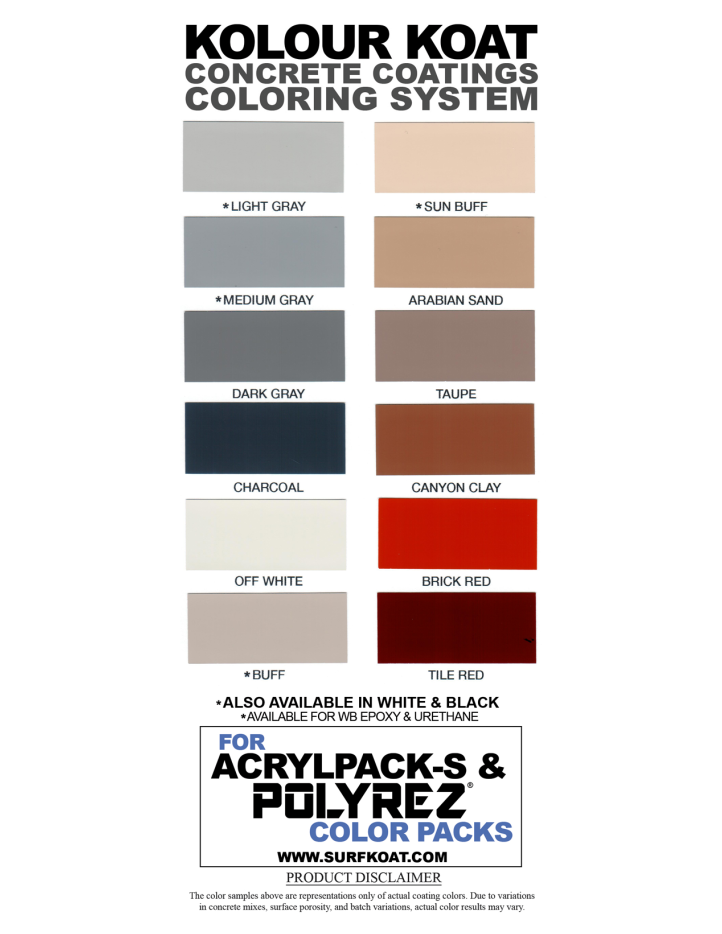 < Click image to enlarge
< Click image to enlarge
Sealer Stain is a unique product that combines staining and sealing concrete into a one-step process. Sealer stain is available as a solid or transparent stain and is applied with a roller on a properly prepped existing concrete surface. This product is solvent based and is recommended for use on exterior surfaces.
Links
Acrylpack-S Technical Data Sheet
Visit our decorative concrete showrooms today to see the big selection of acid stain concrete Chattanooga, Huntsville & Nashville, along with the other types of exterior and interior concrete stain that we carry.
How to Apply Concrete Stain - The Process for Acid Stained Concrete
Adding color to a dull concrete surface is made easy through a staining process. The process for applying concrete stains can take a few days to complete—it can be time consuming, sometimes difficult to achieve (depending on the color), but it is extremely affordable. Interior concrete stain colors can be chosen through a color chart, and they can be applied to fit specific color variations such as logos or school floors, or they can have a more natural appearance. Whether you are professional or you are a homeowner, the steps for staining concrete are the same:
Prepare and clean the concrete prior to staining
It does not matter if you are staining new or old concrete, surface preparation is of the utmost importance prior to staining. All this means is the surface of the concrete needs to be rid of any dirt or scratches. Acid Stains are translucent, so any blemishes or marks that are visible prior to staining will also be visible after staining.
Cleaning the surface of concrete can be accomplished in 2 ways: mechanical grinding or formulated cleaner.
Apply the concrete stain
After the surface of the concrete has been thoroughly cleaned, applying the interior concrete stain is the next step in the process. The materials you will need to apply the concrete stain are:
- Gloves
- Goggles
- Respirator
- Boots
- Roller or Sprayer (depending on the size of the surface)
- Tape
You will need to first tape off the areas you want to protect (doors, door frames, walls, trim. etc.). Once the area has been taped off, you will then need to spray or brush on the very first coat of stain. A sprayer is generally used for larger areas, while a roller or a brush is used for smaller areas and areas that need more precision. Lastly, after the interior concrete stain has been applied, it needs to dry for roughly 20 minutes (depending on the conditions). If more color is needed, simply repeat the process.
Neutralize concrete stain
After the stain has been applied and has had adequate time to dry (approximately 24 hours), neutralizing the stain is the next step in the process. To neutralize the acid the newly applied stain is rinsed with plain water, then applying trisodium phosphate (TSP), baking soda, or ammonia. This step is really only necessary for acid-based stains. Water-based stains do not need to be neutralized.
Seal the concrete for long-term protection
The last step in the process involves applying a protective coat of sealer to the newly stained concrete surface. After allowing the stained concrete to properly, it’s important to apply a sealer. Sealers will help with the longevity of the concrete stain as it will protect it from scratches, marks, and weathering. 2 coats of sealer will need to be applied to properly seal the stained concrete floor.
Sit back and appreciate the work
The last step of the concrete staining process is arguably the most important. Once the drying process is complete, it is important to sit back and appreciate the job you just completed. You deserve a short break!
FAQS
- How do you acid stain concrete?
Concrete acid stain is a liquid that contains various minerals and acid. The acid stain seeps into the pores of the concrete which causes a chemical response between the acid and available lime within the surface. This permanently alters the color of the concrete once acid stained. - What is the most important step in acid staining?
Surface preparation is the most important step when applying an acid stain to concrete floors. Before staining, an area must meet the following criteria: The concrete must be completely free of debris, which requires stringent cleaning. Acid stain cannot mix appropriately with the concrete if anything else is present. - How soon can you acid stain concrete after pouring it?
Freshly poured concrete can be acid stained twenty to twenty-eight days after the pour. - What step of acid staining do competitors frequently miss?
Neutralizing is the most commonly ignored step of the acid stain process. The concrete needs to return to a basic state and be cleared of any unreacted stain and stain buildup after coloring. It’s important to clean off any extra acid buildup, otherwise there will be issues when sealing the stained floor. - How is acid staining different from painting concrete?
Paint sits on top of concrete, whereas an acid stain penetrates the concrete and adds color while allowing the natural concrete to show through. - Are there specific colors that can only be used indoors or outdoors?
Most concrete stains on the market today, whether they are water-based or chemically reactive (acid-based), can be used on both interior and exterior concrete. - Can I see the colors in-person?
Yes, we have decorative concrete showrooms at our Chattanooga, Huntsville, and Nashville locations. - Is this type of concrete resistant to abrasions?
Because acid stains deeply penetrate and chemically react with the concrete, they provide great resistance to fading and wear over time and act as good barriers to moisture penetration. - What brands of concrete stain do you offer?
Our brands are Surfkoat Heritage Acid Stain, Kemiko Stone Tone Concrete Stain, Surfkoat Kolour Dye, and Surecrete Pigmented Acrylics. - Where is the best place to go for acid stained concrete in Chattanooga, Huntsville, and Nashville?
Look no further than Power Rental and Sales.


